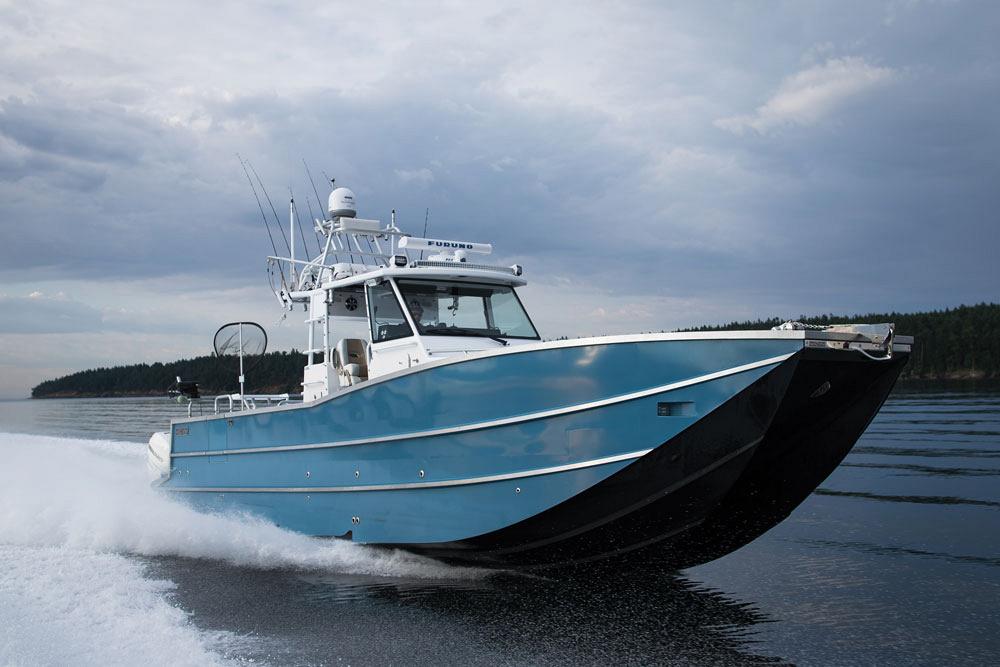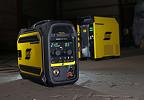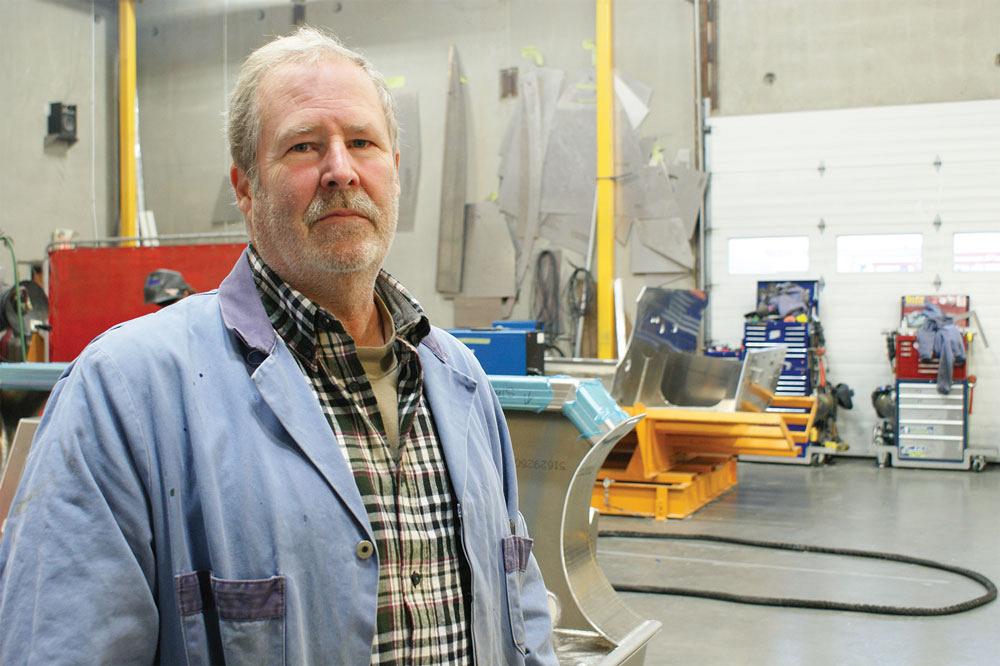- FMA
- The Fabricator
- FABTECH
- Canadian Metalworking
Cutting versatility a must at custom boat shop
Waterjet helps Titan Boats bring hull cutting in-house
- June 15, 2020
- Article
- Fabricating

Titan is an OEM of aluminum rigid-hull inflatable boats. The custom boats it produces are many and varied, of course. Here we see a custom-designed catamaran. Photo by Jay Wallace.
Founded more than 20 years ago, Titan Boats, based in Sidney, B.C., initially focused on manufacturing vessels for the ecotourism industry and governmental agencies in Canada. In 2015, amidst growing demand, the company embarked on a plan to diversify and expand its product line. As a result, the shop needed new, adaptable technology to boost capacity, efficiency, and production capabilities for a broad range of customers and industries. That new technology proved to be abrasive waterjet cutting.
Shortening the Supply Chain
Titan is an OEM of aluminum rigid-hull inflatable boats that started in the basement of the home of John Stanners, the company’s president, in 1998. The company manufactures vessels for the law enforcement, search and rescue, firefighting, environmental, and commercial tourism and recreation sectors. To date it has produced more than 400 custom aluminum boats. In addition, the shop takes on specialty fabrication projects for various customers in other industries.
Operations include welding, bending, metal rolling, and die cutting. The shop operates out of a 10,000-sq.-ft. facility and employs 34.
“In the past we hand-cut all our boat hulls from templates,” explained Jennifer Michell, Titan’s organization development manager. “Then we started using drafting and design software. What we did have in a CAD format, we’d outsource to get waterjet cut. However, being based on an island means that the nearest waterjet machine that could meet the size requirements of our vessels would be off island, resulting in increased shipping costs and lead time. We wanted to eliminate added expenses and reduce lead time with the purchase of our own waterjet.”
Waterjet Impact
Titan wanted a machine that allowed it to work on a variety of projects and materials. After an extensive search, Stanners chose to invest in the OMAX MAXIEM 2080.
This waterjet model is designed for large-format abrasive waterjet machining – a machine that fit the bill for the large-part watercraft fabrication at the heart of Titan’s business. With a cutting envelope of 27 ft. 2 in. by 6 ft. 7in., the machine cuts nearly any material quickly and with precision, minimizing waste and further reducing cost.
“Not only did we see the immediate positive impact insourcing had on cost, we also gained speed in the fabrication of our vessels by being able to cut parts whenever needed on-site,” Michell said. “A vessel build takes the better part of two to three months. If we had to outsource our cutting, that could add an additional four to six weeks.”
Preventive Maintenance
Because productivity is so critical to Titan’s business, the ability to plan preventive maintenance and minimize production downtime was important to the shop as it continued to add customers and take on new projects.
The waterjet comes standard with OMAX IntelliVISOR System Monitoring, a machine performance alert system designed to maximize productivity. By connecting operation controls with machine maintenance and upkeep, it is able to integrate real-time cutting data from the machine through its software interface and machine sensor network for predictive maintenance and controlled production.
Shifts in Customer Demand
Not only is the ability to plan downtime important to Titan, so too is the ability to quickly adapt to changing customer needs, and the waterjet’s versatility allows the company to do just that.
“In relation to flexibility, the waterjet also allows us to better respond and adapt to slow times in one industry by increasing our capability to take on various other projects for customers in other industries to fill gaps,” Michell said. “Having the waterjet aids our ability to diversify our business in response to market changes. We can cut parts for aluminum-hulled watercraft one day and architectural metal and glass the next based on shifts in customer demand.”
Titan’s reliance on CAD technology makes the transition from one type of project to another practically seamless, and the waterjet’s proprietary software, LAYOUT, assists in this. In addition to offering the basic commands found in other CAD programs, LAYOUT allows operators to create automatic toolpaths and provides an entire suite of tools specific to abrasive waterjet machining, including cut quality specifications, toolpath fonts, and gear and rack generation. The software also allows the shop to import drawings directly from other programs, works with standard DXF files and many other file formats, and includes a feature that allows the company to take an image from a scanner, digital camera, or the internet and convert it to a vector drawing.
Though the waterjet features a broad range of optional accessories, Titan opted for the Variable Speed Solids Removal System (VS-SRS) option, which is designed to increase uptime through automated solids removal. The programmable VS-SRS provides precise control over garnet evacuation rate, direction, and duration to efficiently remove garnet from the waterjet catcher tank.
Speedy Delivery
Once the waterjet was installed and the shop received preliminary training on how to use it, the machine went right to work, and the shop experienced an immediate improvement in lead time.
This new level of efficiency has resulted in an enhanced competitive edge for the company because it’s able to deliver orders to customers more quickly. Michell said that with the level of flexibility the abrasive waterjet provides, Titan can easily and quickly switch from cutting 2-in. aluminum to 3-in. plastics or stacked rubber for gaskets. Such versatility has also enabled the shop to broaden its customer base and operations beyond watercraft fabrication.

Titan wanted a machine that allowed it to work on a variety of projects and materials. Stanners chose to invest in the OMAX MAXIEM 2080. This waterjet is designed for large-format cutting.
Because of the company’s investment, downtimes are practically non-existent, and the waterjet is kept busy with projects from customers both near and far.
“Currently we’re working on some custom fabrication projects for Schmidt Ocean Sciences in Palo Alto, Calif. We have three Titan 290 Pilot boats on the waterjet table for the police in Qatar, two brand-new whale-watching models for Wild Whales in Vancouver, a few large Canadian Coast Guard vessels, a Titan 220 D-Tube for the Quebec Department of Fisheries and Oceans, and two Titan 249XL Raptors finishing up for the RCMP,” said Michell. “We’re also completing several retrofits to vessels that are over 10 years old, including two Titan 249XL Raptors for the Los Angeles County Sheriff’s Department.”
Titan Boats, www.titanboats.com
OMAX, www.omax.com
subscribe now


Keep up to date with the latest news, events, and technology for all things metal from our pair of monthly magazines written specifically for Canadian manufacturers!
Start Your Free Subscription- Trending Articles
CWB Group launches full-cycle assessment and training program

Achieving success with mechanized plasma cutting

3D laser tube cutting system available in 3, 4, or 5 kW

Brushless copper tubing cutter adjusts to ODs up to 2-1/8 in.

Welding system features four advanced MIG/MAG WeldModes

- Industry Events
MME Winnipeg
- April 30, 2024
- Winnipeg, ON Canada
CTMA Economic Uncertainty: Helping You Navigate Windsor Seminar
- April 30, 2024
- Windsor, ON Canada
CTMA Economic Uncertainty: Helping You Navigate Kitchener Seminar
- May 2, 2024
- Kitchener, ON Canada
Automate 2024
- May 6 - 9, 2024
- Chicago, IL
ANCA Open House
- May 7 - 8, 2024
- Wixom, MI

















